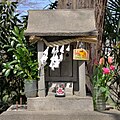Kami are the deities, divinities, spirits, mythological, spiritual, or natural phenomena that are venerated in the Shinto religion. They can be elements of the landscape, forces of nature, beings and the qualities that these beings express, and/or the spirits of venerated dead people. Many kami are considered the ancient ancestors of entire clans. Traditionally, great leaders like the Emperor could be or became kami.

Shinto is a religion originating from Japan. Classified as an East Asian religion by scholars of religion, its practitioners often regard it as Japan's indigenous religion and as a nature religion. Scholars sometimes call its practitioners Shintoists, although adherents rarely use that term themselves. There is no central authority in control of Shinto, with much diversity of belief and practice evident among practitioners.

In Japanese religion, Yahata formerly in Shinto and later commonly known as Hachiman is the syncretic divinity of archery and war, incorporating elements from both Shinto and Buddhism.
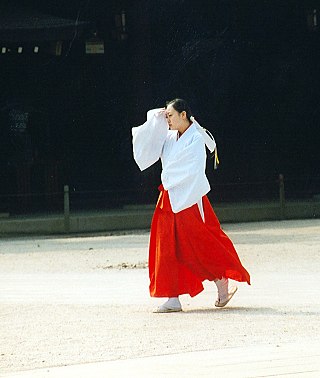
A miko, or shrine maiden, is a young priestess who works at a Shinto shrine. Miko were once likely seen as shamans, but are understood in modern Japanese culture to be an institutionalized role in daily life, trained to perform tasks, ranging from sacred cleansing to performing the sacred Kagura dance.

In Shinto and Buddhism in Japan, an ofuda is a talisman made out of various materials such as paper, wood, cloth or metal. Ofuda are commonly found in both Shinto shrines and Buddhist temples and are considered to be imbued with the power of the deities or Buddhist figures revered therein. Such amulets are also called gofu (護符).

A Shinto shrine is a structure whose main purpose is to house ("enshrine") one or more kami, the deities of the Shinto religion.
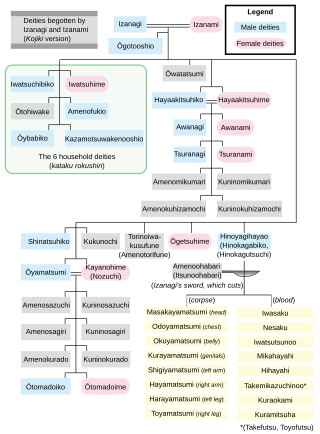
Ōyama-tsumi or Ohoyama-tsumi, also Ōyama-tsumi-mi'oya-no-mikoto (大山祇御祖命), is a god of mountains, sea, and war in Japanese mythology. He is an elder brother of Amaterasu and Susanoo. His other names are Watashi-no-Ōkami (和多志大神) and Sakatoke (酒解神).

Shimenawa are lengths of laid rice straw or hemp rope used for ritual purification in the Shinto religion.

In Shinto shrine architecture, the honden, also called shinden (神殿), or sometimes shōden (昇殿) as in Ise Shrine's case, is the most sacred building at a Shinto shrine, intended purely for the use of the enshrined kami, usually symbolized by a mirror or sometimes by a statue. The building is normally in the rear of the shrine and closed to the general public. In front of it usually stands the haiden, or oratory. The haiden is often connected to the honden by a heiden, or hall of offerings.
The Japanese word mitama refers to the spirit of a kami or the soul of a dead person. It is composed of two characters, the first of which, mi, is simply an honorific. The second, tama (魂・霊) means "spirit". The character pair 神霊, also read mitama, is used exclusively to refer to a kami's spirit. Significantly, the term mitamashiro is a synonym of shintai, the object which in a Shinto shrine houses the enshrined kami.

A mitamaya is an altar used in Shinto-style ancestor worship, dedicated in the memory of deceased forebears. It generally has a mirror symbolizing the spirits of the deceased or a tablet bearing their names and is used not only to enshrine blood relatives, but also to honor respected non-family members.

Dōsojin is a generic name for a type of Shinto kami popularly worshipped in Kantō and neighboring areas in Japan where, as tutelary deities of borders and paths, they are believed to protect travellers, pilgrims, villages, and individuals in "transitional stages" from epidemics and evil spirits. Also called Sae no kami or Sai no kami (障の神・塞の神), Dōrokujin (道陸神) or Shakujin. Dōsojin are often represented as a human couple, carved male or female genitals, large stones or statues, or even tall poles along a road.
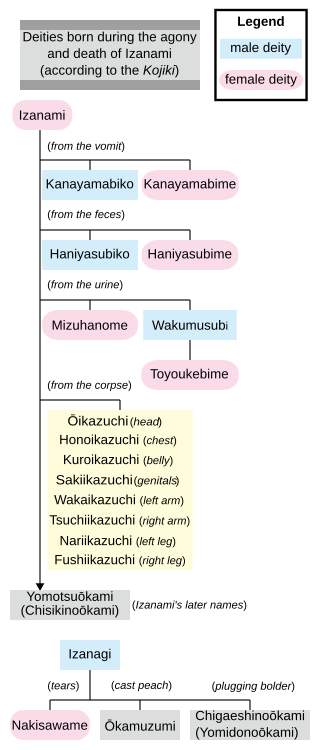
Toyouke-hime is the goddess of agriculture, industry, food, clothing, and houses in the Shinto religion. Originally enshrined in the Tanba region of Japan, she was called to reside at Gekū, Ise Shrine, about 1,500 years ago at the age of Emperor Yūryaku to offer sacred food to Amaterasu Ōmikami, the Sun Goddess.

Kamidana are miniature household altars provided to enshrine a Shinto kami. They are most commonly found in Japan, the home of kami worship.
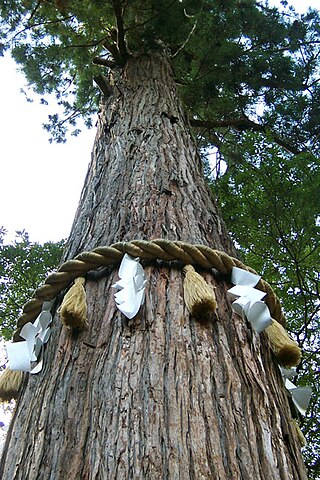
A yorishiro (依り代/依代/憑り代/憑代) in Shinto terminology is an object capable of attracting spirits called kami, thus giving them a physical space to occupy during religious ceremonies. Yorishiro are used during ceremonies to call the kami for worship. The word itself literally means "approach substitute". Once a yorishiro actually houses a kami, it is called a shintai. Ropes called shimenawa decorated with paper streamers called shide often surround yorishiro to make their sacredness manifest. Persons can play the same role as a yorishiro, and in that case are called yorimashi or kamigakari.

This is the glossary of Japanese Buddhism, including major terms the casual reader might find useful in understanding articles on the subject. Words followed by an asterisk (*) are illustrated by an image in one of the photo galleries. Within definitions, words set in boldface are defined elsewhere in the glossary.
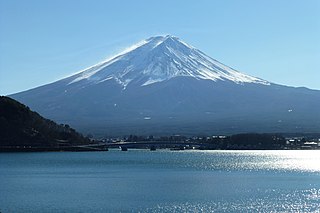
In Shinto, shintai, or go-shintai when the honorific prefix go- is used, are physical objects worshipped at or near Shinto shrines as repositories in which spirits or kami reside. Shintai used in Shrine Shinto can be also called mitamashiro.

In Japan, a chinjusha is a Shinto shrine which enshrines a tutelary kami; that is, a patron spirit that protects a given area, village, building or a Buddhist temple. The Imperial Palace has its own tutelary shrine dedicated to the 21 guardian gods of Ise Shrine. Tutelary shrines are usually very small, but there is a range in size, and the great Hiyoshi Taisha for example is Enryaku-ji's tutelary shrine. The tutelary shrine of a temple or the complex the two together form are sometimes called a temple-shrine. If a tutelary shrine is called chinju-dō, it is the tutelary shrine of a Buddhist temple. Even in that case, however, the shrine retains its distinctive architecture.

Mountain Gods (山神) are Asian tutelary deities associated with mountains. They are related to landlord deities and tudigongs and City Gods.
Shinto is a religion native to Japan with a centuries'-long history tied to various influences in origin.




